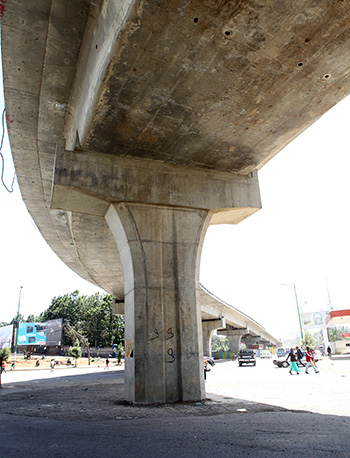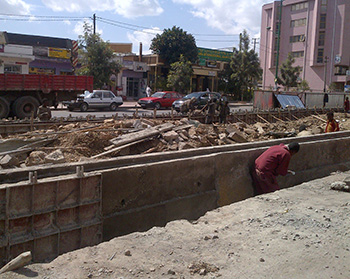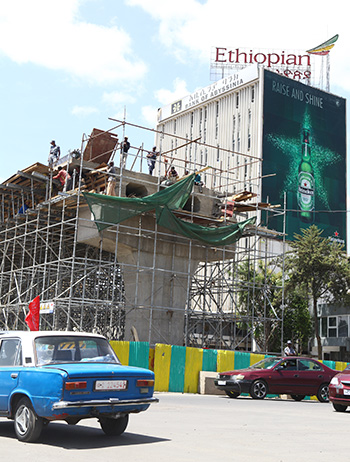Infrastructure development in Ethiopia: Building Ethiopia’s infrastructure with billions of birr
Ethiopia Sector Analysis
Infrastructure development in Ethiopia: Building Ethiopia’s infrastructure with billions of birr
Ethiopia’s commitment to improve the state of its infrastructure is already showing its serious character. Transport, electricity (power), telecom and construction of educational as well as health centers have been at the forefront of improvement.

Infrastructure development in Ethiopia: Building Ethiopia’s infrastructure with billions of birr
By Bewket Abebe
ADDIS ABABA – “The infrastructure development in this country is the basis for the economic growth and a huge push is being made for this by the public sector in order to have a vibrant economy in the nation,” claims Getachew Regassa, secretary general of the Addis Ababa Chamber of Commerce & Sectoral Associations (AACCSA), who is representing the private sector in Ethiopia. Indeed, nobody doubts the development of the infrastructure sector in Ethiopia.

“We really want to focus on the infrastructural projects. We don’t want to lose our focus and attention from that. The main growth especially in Ethiopia is with infrastructure,” explains Aboma Taye, managing director of Baraton Trade, the leading provider of drilling machinery for infrastructure projects in Ethiopia and East Africa.
Led by public investment, the infrastructure sector is among the sectors which make the country’s fast economic growth indisputable and visible enough. It is just an emerging area where the country’s ambitious target is on track and highly promising.
Despite a number of issues that the current administration in Ethiopia failed to address, there has been a visible progress when it comes to infrastructure, emanating from a serious commitment. In every aspect of infrastructure, a huge investment, which takes the larger share of the country’s budget, has been undertaken. Transport, electricity (power), telecom and construction of educational as well as health centers have been at the forefront of improvement. Ethiopia has recently started devoting about 1.3 billion USD to the infrastructure sector each year.
Transport
In order to accomplish the transport targets—build 14,787 km of roads and increase the road network up to 64,500 kilometers in between 2010 and 2015—the government has allocated 1 billion birr for this particular area. A number of privately owned construction companies are also highly involved. “Currently, 80% of our revenue is generated from building construction and the remaining 20% is split between water and roads,” says Tsedeke Yihune, owner of Flintstone Engineering, one of the largest construction companies in Ethiopia.
To date, 9,156 km of roads were constructed. As a result, the majority of the main lines—which have been gravel roads built during the Italian occupation in 1936—are now asphalted and the major lines are connected with each other.
“The infrastructure development in this country is the basis for the economic growth and a huge push is being made for this by the public sector in order to have a vibrant economy in the nation.”
In addition, a light railway project (2.6 billion birr) limited to the capital of Addis Ababa is under construction and is expected to be completed by mid-2015. Once completed, it will serve nearly 65,000 passengers at a time in all four directions of the city. The railway will substantially ease the transport problem in the capital.
The air transport, which is represented by the Ethiopian Airlines, has also witnessed certain positive developments. Though the company is a state monopoly, the airlines’ infrastructure has become competitive enough. Introducing the latest aircrafts,Ethiopian Airlinesis claimed to be the leading African airlines. Last year alone, the airlines added 10 Boeings 787 Dreamliner to the existing fleet. Ethiopian Airlines is currently one of the most profitable and largest institutions in the country. “It is a profitable and growing company,” says Colonel Wosenyelh Hunegnaw, director general of Ethiopian Civil Aviation Authority. The airline’s annual profit has reached 2.1 billion USD and it aspires to increase it to 11 billion USD by 2025.
Regarding the maritime transport, Ethiopia remains dependent on the neighboring countries’ ports, e.g. in Djibouti.
Telecommunications
The telecom industry is another area where a large investment (3.1 billion USD) is being undertaken. Since the late 1990s when Ericson started its operation the sector went through a number of reforms. To date, the number of mobile subscribers multiplied and reached 22 million in less than three years. The target is to increase the number of subscribers to 50 million.  Nonetheless, the telecom infrastructure poses one of the most serious problems not only to businesses but to literally anyone who owns a card from Ethio Telecom. Internet penetration is lagging behind, too.
Nonetheless, the telecom infrastructure poses one of the most serious problems not only to businesses but to literally anyone who owns a card from Ethio Telecom. Internet penetration is lagging behind, too.
To address this, the two rival Chinese telecom giants ZTE and Huawei signed a 1.6 billion USD vender financing agreement, which will last for the coming two years.
For the time being, government prefers to keep the sector closed for any local or international telecom players. “I know my boss, the owner of MIDROC, had that vision (i.e. the vision of getting involved in the telecom sector) 13 or 14 years ago before I came here. Possibly he did propose a plan. I am sure he is waiting for the opportune moment to get involved in it,” explains Dr. Arega Yirdaw, CEO of MIDROC Ethiopia Technology Group, which is a part of the largest group of companies in the country. A recent research conducted by Addis Ababa University revealed that the country could have earned tenfold from taxation of the sector had it allowed private companies to operate.
Power
Unlike the telecom industry, the power segment is steadily progressing and growing. The total power capacity of Ethiopia is now 2,300MW. Few giant projects are underway in order to increase the capacity further. Ethiopia has a total of 18 power projects at the moment. The Grand Renaissance Dam, which is being built on the river Nile, is supposed to generate additional 6,000MW. This will enable the country to export electricity to seven different countries in the region. It is of course a demanding project given that the total cost is to be covered by Ethiopia itself following the ban of any foreign loan due to Egypt’s objection over the share of the water flow. Also, there is another project that is supposed to increase the country’s total power capacity to 37,000MW.
Construction of educational and health institutions

Ethiopia had four universities ten years ago. Today there are 32 public universities and 67 private colleges. This is the result of the cooperation between the infrastructure sector and the skilled manpower. “If you had asked me twenty years ago, I would have said it was very horrible and very difficult. Ten years ago, it was better.
Last year, it was getting even better,” says Eng. Samson Bekure Tefera, managing director of SABA Engineering, which is involved in the construction of higher educational institutions, among others. “This is because the Ethiopian government has focused on higher education. When I started, there was only one university,” he reminds.
In terms of the primary education, infrastructure played the greatest role which enabled 94% of children across the country to access education. In this regard, MGDs expectations were met. The Net Enrolment Ratio (NER) in the lower primary school cycle (grade 1 – 4) has thus increased from 77.5% in 2004/05 to 92.2% in 2011/12 and from 37.6% to 48.1% in the upper cycle primary education (grade 5 – 8) within the last eight years. Nevertheless, the quality of education, especially in the higher education, remains a lasting challenge.
The number of new health centers and health institutions at all levels increased, particularly at the lower level. Coupled with the health extension package, infrastructure in the sector has saved lives of many children as well as helped the country meet the MDG on combating HIV/AIDS, malaria and tuberculosis by 2015. As a result, the estimated HIV/AIDS prevalence amongst the adult population has dropped to 1.5% two years ago against the MDG target of 2.5%. Infant mortality has also been reduced by 33%—from 43.2% to 28.7% in the 2010/11, which is greater than the reduction registered in the sub-Saharan Africa (by 18%) and worldwide (by 24%). The infrastructure in the health sector also enabled the country to significantly lower under-five child mortality by 28.4% within five years. It is now 88 per 1,000 live births. Despite these very promising figures, the MDG on maternal mortality has not been met yet.
All in all, Ethiopia’s investment in the infrastructure sector is largely fruitful though a lot remains to be done for the country in order to attain the middle income level by 2025.
FAIR USE POLICY
This material (including media content) may not be published, broadcasted, rewritten, or redistributed. However, linking directly to the page (including the source, i.e. Marcopolis.net) is permitted and encouraged.